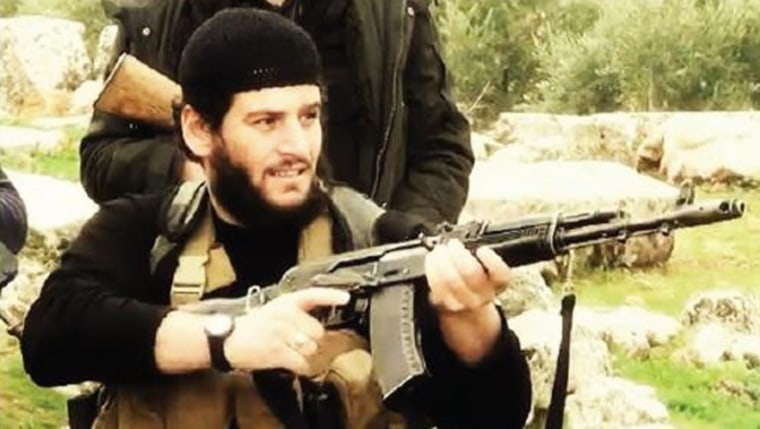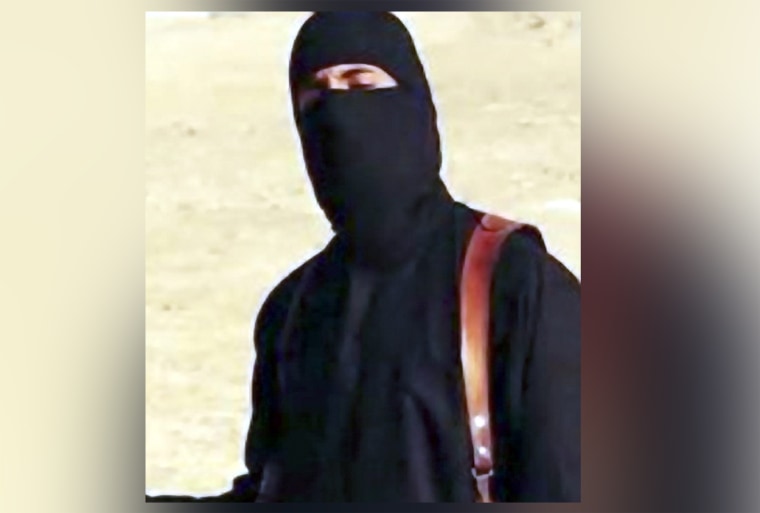He is America’s most wanted — the number one name on the government’s kill list of ISIS leaders, say senior U.S. military and intelligence officials.
Abu Bakr Al-Baghdadi may be the face of ISIS, but Abu Muhammad al-Adnani, the terror group’s director of external operations, is the man most likely to cause harm in the West. The U.S. wants al-Adnani dead because he’s considered the author of the strategy of wanton murder that has left more than 500 dead in attacks around the world since October 10 — and apparently helped inspire last week’s massacre in San Bernardino.
"He is at the top of the list," confirmed a senior intelligence official.
"We are tracking him," said a senior U.S. military official. "We believe he is in Iraq."
Laith al-Khouri of Flashpoint Intelligence, an NBC counterterrorism analyst, said the rationale for the U.S. interest in killing Adnani is simple.

"Adnani has been the main voice behind issuing ISIS threats to the West," said al-Khouri. He is also dangerous, said al-Khouri, because his charisma draws new followers to the group. “He is so admired and glorified by jihadists worldwide that he stands as a primary point of recruitment."
Since the November attack in Paris that killed 130, U.S. officials have come to see the 38-year-old al-Adnani as the ISIS version of Khalid Sheikh Mohammad, the al Qaeda leader who masterminded the September 11 attacks. Counterterrorism officials say al-Adnani likely "greenlighted" the complex Paris operation, working through Abdelhamid Abbaaoud, who ran the operation and then died in a police raid.
But in addition to those acts of violence directed or "greenlighted" by ISIS, sympathizers with the group have followed tenets established by al-Adnani to mount their own assaults. Al-Adnani encouraged attacks around the world in a video statement published online in September 2014, the day after the U.S.-led coalition launched its first airstrikes against the ISIS “caliphate” in Syria and Iraq.
"If you can kill a disbelieving American or European — especially the spiteful and filthy French,” said al-Adnani, “or an Australian, or a Canadian, or any other disbeliever from the disbelievers waging war, including the citizens of the countries that entered into a coalition against the Islamic State, then rely upon Allah, and kill him in any manner or way however it may be."
"Smash his head with a rock, or slaughter him with a knife"
Al-Adnani’s resume helped him reach the top ranks of ISIS. He was one of the first foreign fighters to oppose U.S. Coalition Forces in Iraq, crossing the border from his native Syria into Iraq in 2003. He swore an oath of allegiance to Abu Musab al-Zarqawi, the Al Qaeda in Iraq leader later killed by U.S. fighter-bombers. He also reportedly was captured in 2005 and taken into custody at a camp run by the U.S. military, but was released after five years in 2010. He was arrested and held the whole time under an alias.
At the time of his release, he was not seen as a significant player. Not long afterwards, however, he began appearing as a media spokesman for ISIS, becoming the "leading conduit for the dissemination of official messages," as the FBI described him. When ISIS declared a caliphate in June 2014, it was al-Adnani who issued the statement calling on "Muslims in all places" to emigrate to the Islamic State. And it was al-Adnani who rebuked al Qaeda leadership when they challenged the legitimacy of the Islamic State, opening a jihadi schism.
By September 2014, al-Adnani's portfolio had apparently expanded. He became director of external operations. On September 21, the morning after coalition bombers attacked ISIS targets for the first time, al-Adnani responded with a call for Muslims to attack virtually any citizen of the coalition.
Over the next few weeks, there were a series of attacks by "lone wolves" that law enforcement and intelligence officials believe were a direct result of al-Adnani's call to arms: an axe attack on police officers in Queens, N.Y., a deadly assault outside the Canadian Parliament building in Ottawa, and the murder of a Canadian soldier in Quebec by a driver who deliberately drove his car into a small group of soldiers. Now, suggest U.S. intelligence officials, there is another more sophisticated wave.
For all his bravado, al-Adnani is notoriously camera-shy. American officials believe he avoids photos and video because of security concerns. His video message urging attacks on the “filthy French” was actually just audio over a brief still image of him posing with a gun, and his face was blurred in the official ISIS video celebrating the founding of the caliphate.
In the next few weeks, expect the U.S. to step up its operations against the ISIS hierarchy, targeting the group’s leaders with Predator drone strikes or snatch-and-grab operations.

In the past six months, the U.S. has killed a half dozen ISIS leaders — on Thursday, both ISIS and the White House confirmed that ISIS finance chief Abu Saleh had died in a November coalition air strike. The U.S. has also killed Abu Sayyaf, the group's "oil emir"; Haji Mutazz, its second-in-command; Junaid Hussain, a key recruiter and social media guru; Abu Nabil, leader of ISIS in Libya: and Mohammed Emwazi, a.k.a “Jihadi John,” the notorious ISIS executioner in Iraq and Syria seen beheading hostages on video.
But the man the U.S. government really wants is al-Adnani. And considering the U.S. record against the individuals who held the same job in al Qaeda, the drones and special forces may succeed. Six times, the U.S. killed or captured Al Qaeda's director of external operations, starting with the capture of Khalid Sheikh Mohammed in Pakistan in 2003 and extending, most recently, to Nasir al-Wuhayshi, killed in a U.S. airstrike in Yemen this summer.
